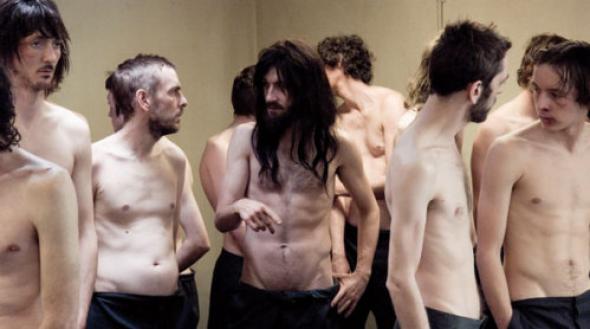Hungry Ghost
Steve McQueen's controversial film about Irish republican hunger striker, Bobby Sands, eschews an articulation of politics, dramatising, instead, the body's capacity to ‘speak'. But this microscopic focus on the flesh leaves us hungry for the political passions that animated it, writes Paul Helliwell
‘Words are shit, because they put you somewhere else.
I’m trying to catch the things that are in between.’
– Steve McQueen
A poll of critics in Sight and Sound (January 2009) has hailed Hunger as the best movie of 2008 and the arrival of Steve McQueen as a serious film-maker. It is an example of the film's surprisingly smooth reception in the UK and Ireland, given that it is based on the deaths of ten men on hunger strike in a British prison; men who had taken up arms against the British State. But it has not been uniformly smooth, with David Cox in his Guardian blog intent on reopening the wounds of the time: ‘Far from being shocked at seeing the inmates roughed up a bit, I found myself wishing they'd been properly tortured.'1Who? The actors? There is a confusion of film and reality here. A desire to show the differences between now and then. Let us pursue them.
Re-enactment in politics often affirms the closure of questions, fixing meanings. In art or film it often serves to re-open questions, to bring something back. In both there is a faith that re-enactment is not numbing repetition but rehearsal, practice making perfect.2 Think of the Northern Ireland marching season as an attempt to legitimise protestant ascendancy, to prevent the redistribution of roles within Ulster. But what are the aesthetics and the politics of McQueen's re-enactment, narrative and mise-en-scène? What is the redistribution being proposed here? What is McQueen trying to bring back?
‘McQueen and his collaborators take us to a time and place that already seems unimaginable', says Ian Christie in Sight and Sound. To be honest, it is not just the worryingly accurate '70s and '80s clothes, breakfasts, gender roles, suburban repression, and concrete that seem unimaginable, but the degree of political conviction of those years. The end titles tell us the hunger strike ended with the recognition of every demand but the key one - that republican prisoners be recognised as political prisoners and treated as a special category. Just as the war in the six counties (or ‘the troubles', if you will) ended with a recognition of almost every demand but the key one - that of a united Ireland. The ‘no-state' solution is simply not recognisable as the object of the prisoners' struggle. As Bobby Sands' sister Bernadette Sands-McKevitt put it, ‘Bobby did not die for cross-border bodies with executive powers'. Neither is it recognisable as the object of the struggle of the wider republican movement, nor indeed that of the loyalists. This is not the ending anybody imagined at the time. But does this really make that time unimaginable now? As Vikki Bell notes in her study of the Civic Forum, there the past and its politics must be dealt with carefully to prevent a collapse of civil society back into sectarianism. The peace remains haunted.3
There can be few who actively want to bring back ‘the troubles' - so what is it McQueen wants to bring back? As he has repeatedly emphasised in interviews, what his 11-year-old self found inspiring when he first saw Bobby Sands on the news, and the artist of the present continues to find inspiring in Northern Ireland, is the idealism shown by all sides. In the film it is this abstract idealism that drives the violence, displacing politics from its rightful place.4 This displacement is deliberate. For McQueen, the film is ‘steeped in politics', however, he continues, ‘politicians make a situation, but I'm interested in how people deal with that situation.' Robin Gutch, the producer of the film, added, ‘I think what Steve and his team have done is restore the humanity to something that was clouded by a lot of ideology and rhetoric and posturing on all sides.'5
It is a brave decision to tackle this subject, but if there is one consistent criticism of films that have previously used ‘the troubles' as material it is their repeated de-politicisation of peoples' motivations.6 Foucault, commenting on French films, said that to make de Gaulle appear the saviour of the nation required hiding the extent of the resistance to the Germans: ‘people are shown not what they were but what they must remember having been.'7
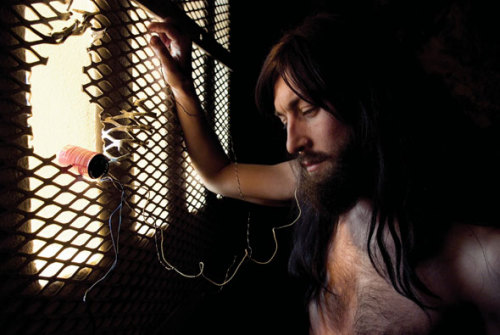
In Hunger, this de-politicisation is achieved by the additive nature of events on screen (and then..., not, and so...), mere practices previewed, echoed and rehearsed until they become static, embedded in epic rather than narrative time. Like the journey of Ulysses, we all know how this is going to end, but the events do not help us get there. Do the messages passed by the prisoners to their visitors cause the murder of the prison guard? We must decide, for we are neither shown nor told. It is a relief not to be hustled along by narrative, by plot mechanics, but while this collage of events (like the new Northern Ireland) has enough space for everybody, it has no room for their motivations. These we fill in as we choose. The width of McQueen's frame allows him to show the grain of concrete and of human flesh close up, but also to stage some egregious pieties: a riot policeman's cries (while his colleagues get on with the beatings), and a prison hospital orderly with ‘UDA' on his knuckles carrying a dying Bobby Sands. Ideal reconciliations - we are all human, we all have ideals, and we all share the frame together.
In a film called Hunger, the gnawing of physical hunger is absent. In a filmed interview, McQueen explains that what attracted him to the story was the idea of not eating to make your voice louder, as he makes a gesture of gathering the food to his lips and then releasing it as speech. This is a reading similar to those of anorexia which understand it as an attempt to gain control of orality by refusing to eat. To his credit, McQueen uses it not as a means of explaining away the hunger strikers' actions but as a practice.8 For McQueen is interested in repeatable practices, an archaeology of limit experiences. He wants us to see and experience ‘something you cannot find in books and archives', ‘the actual shit of history'.9 This is McQueen's hunger. He is the hungry ghost, returning to eat, hungry for experience, and this is why the film, having brought us twice to the H-Blocks, keeps us there almost entirely until the end.
This is a movie of bloody knuckles and suppurating bed sores, but also of shit smeared on the walls and mounds of rotting food refuse in the cells. For the practice McQueen is really interested in is not the hunger strike, but the blanket and dirty protests - the refusal to wear prison uniform and slop out the excrement from the cell - shown in the first third of the movie. Here the shots inside the prison that do not feature the suffering human body show the dirt and abjection in which the prisoners lived for four and a half years - in one long, fixed-position shot, piss flows from under closed cell doors before it is disinfected and swept back in by a masked and rubber suited prison officer. The piss is caused to flow out under the doors by means of a dam of festering food remains (we know this because we have been shown it earlier but now the men doing it remain hidden). In the unlikely event that this scene could have been filmed in the '70s, this would probably have been portrayed as resistance and prank. Now we see these as if they were aesthetic practices documented on video and shown in an art gallery.10 However visceral the violence or vile the filth, it is all form because we are at an aesthetic distance from its motivations. As Fintan O'Toole notes, the blanket men have become a kind of wish fulfilment of the avant-garde artist.11
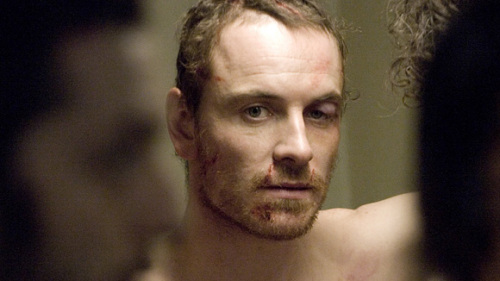
For McQueen, the filth is fertile. It is the revolutionary city (of Bobby Sands), to be counterposed with the cleanliness and psychoanalytic repression of the suburbs that motivates the prison guards to clean and clean again, and the untrustworthy, false paradise of the countryside (where the priest comes from). It is an alchemical purification towards an ideal through corruption. When McQueen says it's a surreal situation, he means it not in the sense of being improbable but that the Surrealists would recognise it: ‘In history as in nature, the rotten is the laboratory of life.' Then as now the question, disputed between Bataille and Breton, is: can the rotten suffice instead of politics?12
What were the politics of these practices that have been displaced by both history and McQueen? First we need a little context, but the beginnings can be made using Foucault's work on punishment and prisons in Discipline and Punish.13
For the British State, in 1975, it was necessary that the six county ‘statelet' of Northern Ireland be normalised as part of the United Kingdom with (to all appearances) the same laws and penal policies as the ‘mainland'. Moving it from a colonial war to a policy of ‘Ulsterisation and Criminalisation', new IRA prisoners had to be jailed as criminals. This replaced the colonial policy of internment without trial, and hid the Emergency Powers Act and no-trial-by-jury Diplock courts. From the prisoners' side, their main aim was to challenge the right of the State of Northern Ireland to jail them by refusing to be produced as criminals by their imprisonment and to assert military discipline. This rejection of the prison is an attack on the legitimacy of the state as deriving not from an abstract ‘above', but from its institutions, an attack on its sufficiency.
If the crowd gathered round the scaffold, it was not simply to witness the sufferings of the condemned man [...], it was to hear an individual who had nothing more to lose curse the judges, the laws, the governments and the religion [...]. Under the protection of imminent death.14
Foucault argued that with the prison, punishment dare not speak its own name and instead becomes correction or cure. Instead of the condemned being tortured to death in public, they are instantaneously dispatched by lethal injection behind high walls, as if the judgement at public trial were sufficient punishment and the judicial murder a necessary but troubling detail. Prisons are run to timetables with adequate food, sanitation, and clothing - beatings and physical pain their dirty secret. These refusals by the prisoners to wear prison uniform, to slop out their excrement, and finally to eat were a contestation of the prison's logic of hiding and eliminating society's waste people. An elimination blocked, in microcosm, within each cell.
Prisoners and their supporters smuggled out their accounts (‘comms' - another practice shown at length in the film) and ensured their publication.15 What this brought back, however, was a public punishment of the body of the condemned that had been replaced all over Europe in the early 19th century. As Foucault notes, the problem with the spectacular punishment of the body was that ‘it was always ready to invert the shame visited on the victim into pity or glory' - from Jesus to Jesse James, these ‘ambiguous rituals' invert into martyrology. Prison was to stifle words spoken ‘under the protection of imminent death' by secluding prisoners and by hiding the ‘excesses' and survivals of the earlier regime. Yet the earlier regime remains something that can be re-invoked by the state and its citizens equally; a demand that ‘the punishment should fit the crime' exactly, so as to equal and erase it - an eye for an eye.16 In Hunger, the beatings are preceded by the removal of the prisoners' record cards from the slot outside their cells, but this merely reveals the limits of the protection offered by the prison. Now we are often reduced to calling for the reinstatement of that protection as torture and ghost prisons have returned, as the footage of the hanging of a tyrant ‘leaks'.
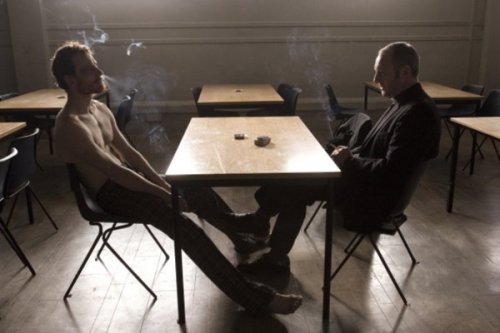
It is important to distinguish the political logic that led the Provisional IRA to allow the hunger strike to go ahead - the messy, insufficient logic of events - from the necessary logic of the film's story. There is no conveniently cast Judas or Coward Robert Ford, so the film must provide a reason as to why Bobby Sands and the others chose a road that we know will lead to their deaths - it is the central problem, the one thing in the movie that requires a cause. McQueen resolves it through a long, exhaustively rehearsed, nearly single-shot take between Sands and a Priest. It is difficult to tell what the film would have been if he had followed his original intention to have it without dialogue throughout; then again, he has also been reported as saying this scene was ‘always there'. (On DVD we can, perhaps, try the film without it.) Film critic Demetrios Matheou says it's a scene ‘to rival that of Pacino and De Niro in Heat'.17 But that is the least of its problems.
Structurally, the film must provide Bobby Sands with a story that makes his death necessary. Here's the spoiler. A foal with a broken back leg is floundering in a stream in a forest, suffering, getting cut up by the rocks (this is when Sands is 11 or so, he's there as part of a cross country running team). He shoulders the responsibility, drowns the foal and takes the blame because he knows he's strong enough to bear it. I can see this scene clearly in my mind, but in the film it's only talked about. From then on we are committed to humanely killing the foal, to political struggle; we are prepared to accept the necessity of Sands' death. In the film's nearly wordless last third it all goes a bit 2001: A Space Odyssey. As he sickens, and again, as he dies, Sands has a vision of himself as the 11-year-old runner. If indeed it hadn't earlier - the spiral of shit a prisoner daubs on the wall is accorded the same cinematic reverence as the black monolith. Transcendence is hard to show.18
And as I read it back I find this shaggy pony story unsatisfying. The script has incorporated the story of the killing of the foal as a moment of realisation, one that is much more powerful than the attempted elucidation of the prisoners' political situation in respect of the republican movement and the British government immediately prior to it in the scene. To use the stock phrase ‘it was then that I realised', I had been moved by the kind of journey storytelling politicians think more effective than ‘hard' facts. I'm not thinking Pacino and De Niro here, I'm thinking of Tony Blair telling us of meeting ‘Sierra Man' while canvassing and realising at that moment that Labour needed to change to become electable. Everyone likes a story and we are not averse to accepting something as a fact because it seems it should be true.19
In his Frieze magazine review ‘Flesh Becomes Words', Caoimhín Mac Giolla Léith maintains that McQueen distrusts language and instead favours the visceral qualities of sound.20 Mac Giolla Léith recognises the role of a performative storytelling in Hunger and two of McQueen's earlier artworks (7th November and Girl's Tricky), but he holds that these stories are undermined, made insufficient, and that the failure of the dialogue between the priest and Sands to prevent the hunger strike is an example of this distrust. (This is a good story but we already know the hunger strike went ahead - this only works if McQueen is dramatising his own distrust of language, but he needs this scene to work.) He quotes McQueen as saying, ‘Words are shit, because they put you somewhere else. I'm trying to catch the things that are in between.'
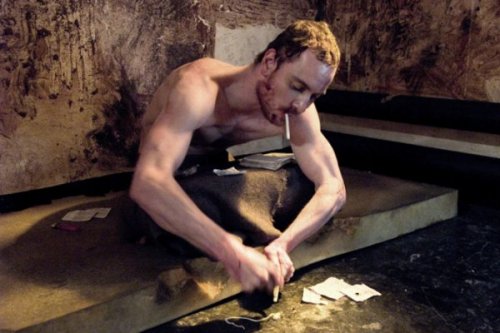
It is a philosophical commonplace that behind the fog of words is real direct experience. McQueen wishes to take us there and to experience it himself, just think of the conditions under which this film was made (in a prison, with starved actors and mounds of festering food refuse). If ‘words (are shit)' is the bad in the opposition McQueen has constructed, his good is probably the body as a site of unmediated experience. But the true lesson of the folk stories in which Trickster, Hermes, Anansi or Raven find something valuable in a pile of shit (after searching for years and getting very dirty) is that another distribution is possible; a collapse of false opposites, such as sought by the Surrealists. What McQueen is searching for is to be found in his shit, in the ‘ideology and rhetoric and posturing' he has discarded, in the politics he has divorced from people dealing with situations, but finally, in words.
McQueen has confined the words to one scene, words necessary to prevent a ‘misreading' of Sands' motivation. But Mac Giolla Léith takes this distrust further. The flesh the hunger strikers lost was transmuted into words, words laboriously smuggled out, but so many words that they are not worth reading. And these are what have really been lost from this film, these words and the politics and the movements that these words called into being, the flesh of these words. It is not that ‘men and events appear [...] as shadows that have lost their bodies', but that men appear only as bodies, events as shadows, and their words as silence.21 Everyone has been spoken for.
McQueen has spoken of the process of making the film itself not just in a manner reminiscent of relational art, but as if it was a therapeutic working through, as if art had better process than politics:
When a person whose father or uncle or sister was involved in ‘the troubles', and they can do something about it physically, involve themselves in the making of the film, then they feel empowered by the physicality of doing something within that.22
But there is a fear of re-enactment here also. Permission to shoot inside the H-Blocks themselves was refused so Hunger was shot elsewhere, ironically on sets based on the Baader-Meinhof prison (whether sets from the film Baader Meinhof Complex, or based on Stammheim prison or both is not made clear). McQueen views the denial of permission to film within the H-Blocks as a blessing because he was unsure of what ‘atmosphere' it would have cast over the crew.23
McQueen has a topical hope that the film will help in the understanding of how ‘idealism' makes martyrs. He could not be more wrong. It is not idealism that makes martyrs, but politics. He is afraid that the past will steal its scene, for the present that has reconfigured the past remains haunted by what is eliminated. McQueen has made a film on ‘the troubles' that manages to eliminate the presence of the British Army, leaving only Margaret Thatcher's disembodied voice. What would disappear from a film about the Gulf War?
The pointy hood, the electrodes, the prisoner who stands on a box. It is not a Goya - it is a human being tortured. Here art effects no redistribution but of itself.
Paul Helliwell <p.helliwell2000 AT yahoo.co.uk> would like to direct people to his blog on the myspace page of his ‘brother ass' horsemouth: http://www.myspace.com/horsemouthfolk
Info
Steve McQueen, Hunger, 2008
Footnotes
1 David Cox, ‘Hunger strikes a very sour note', http://www.guardian.co.uk/film/filmblog/2008/nov/03/hunger-bobby-sands . Comments such as these generated over 700 postings within ten days before the tail was shut down. The adjudication by readers' editor Siobhan Butterworth itself generated a further 400 comments.
2 See Hillel Schwartz, ‘Once More With Feeling', in The Culture of the Copy, New York, Zone Books, 1996, chapter 7. Artists have shown great interest in re-enactment; Melanie Gilligan has been the only one, to my knowledge, bucking the trend by being interested in pre-enactment, the ability of role play to tell the future, taking her cue from books such as Michael D Schrage's Serious Play: How the World's Best Companies Simulate to Innovate, Harvard Business School Press, 1999.
3 Foucault's concept of ‘Governmentality' might be a useful guide here as to how a state can be reformed as just the sum of its administrative arrangements rather than as that from which sovereignty derives. See Vikki Bell, ‘Spectres of Peace: Civic Participation in Northern Ireland', Social and Legal Studies, Vol.13, No.3, pp.403-428. The Civic Forum, composed of representatives from the business, trade union and voluntary sectors, was established as part of the Northern Ireland Act of 1998 to act as a consultative mechanism.
4 In Sight and Sound, Colin McCabe notes with approval that McQueen has ‘navigated the politics of Northern Ireland by studiously ignoring them'; Ronan Bennett, an earlier prisoner at Long Kesh/the Maze has applauded his ‘eschewing explication'; Maria Fusco, in Art Monthly, noted that politics was the ‘one thing missing'. See ‘Films of 2008', Sight and Sound, January 2009; Ronan Bennett in, http://www.guardian.co.uk/ politics/2008/oct/22/maze-prison-film-northernireland-hunger
5 See, http://www.eyeforfilm.co.uk/feature.php?id=563
6 John Hill, ‘Images of Violence', in Kevin Rockett, Luke Gibbons, John Hill, Croom Helm (eds.), Cinema and Ireland, Syracuse University Press, 1987, pp.147-193; and Ruth Barton, Irish National Cinema, Routledge, 2004, pp.157-78. Not to mention an extremely effective campaign of censorship of the news aimed at the same thing. See Liz Curtis, Ireland and the Propaganda War, Pluto Press, 1983.
7 Michel Foucault, ‘Film and Popular Memory', in Foucault Live, Sylvère Lotringer (ed.), Semiotext(e), 1989, p.123.
8 See, http://www.filmcatcher.com/interview_detail/ 152/ . Caoimhín Mac Giolla Léith draws a comparison with Maud Ellman's The Hunger Artists: Starving, Writing and Imprisonment, Virago Press, London 1993. The psychoanalytic reading is seen in an inverted Oedipal scene told as a joke by the prison officer, one spread over an additional generation. The punch line, ‘See it's not so funny when it's your mammy', leaves the child Oedipus having the last laugh. If Oedipus is interpreted as challenging the father for language then this can be interpreted as keeping the right to speak open. This is arguably McQueen's aim.
9 Tony Rayns, ‘Hunger', p.63; and Kieron Corless, ‘BFI 52nd London Film Festival and Interviews', pp.24-27, both in Sight and Sound, November 2008.
10 This scene is something of an exception. Something of the prank still remains in that, with no human actors, what it most closely resembles is Fischli and Weiss, The Way of Things.
11 Fintan O'Toole, ‘Hunger Fails to Wrest the Narrative From the Hunger Strikers', Irish Times, 22November, 2008, http://www.irishtimes.com/news paper/weekend/2008/1122/1227288132671.html
12 Alan S. Weiss, ‘Between the Sign of the Scorpion and the Sign of the Cross: L'Age D'Or', in, R. Kuenzli (ed.), Dada and Surrealist Film, MIT, 1996, p.169. Most of this chapter can be read on Google Books. See also Paul Hammond (ed.), The Shadow and its Shadow, BFI, 1978.
13 The struggles of republican prisoners should be contrasted with the post-'68 struggle in France, where jailed Maoists abandoned their hunger strikes and demands for a separate political category and it became over prison itself. The IRA protests should be understood not as against prison itself, but functioning by means of prisons. See, http://www.espacestemps.net/ document1164.html See also the second half of ‘On Attica' in Foucault Live, Sylvère Lotringer (ed.), Semiotext(e), 1989.
14 Michel Foucault, Discipline and Punish, trans. Alan Sheridan, Vintage, 1979, pp.60-1.
15 These would perhaps provide a better basis for a Foucauldian study rather than the ad hoc use of Foucault's themes and examples that has been attempted before and that I repeat here. See Martin Wainright and Ben Quinn, ‘The Past is So Last Year: New Archaeologists Dig the Present', The Guardian, 22 December, 2008.
16 The state abrogates the people's right to punish. The death threats which defence lawyers receive in high profile cases and David Cox's demands to see IRA members properly tortured arise because of this. Also, Death Wish, Batman, Dirty Harry etc. See ‘Anxiety of Judging' in Lotringer op. cit.
17 Interestingly, Heat was a remake by Michael Mann of his own earlier TV movie LA Takedown. While it doesn't feature great actors, at least it doesn't have the scenes designed to produce great acting.
18 It also has a psychic twin in Carol Read's Odd Man Out, where Lukey the artist wants to paint Johnny, a wounded IRA man on the run, to catch him as he passes from one world into the next.
19 For a good discussion of this instrumentalisation of structuralism with examples see, http://news.bbc.co.uk/nol/shared/spl/hi/programmes/analysis/transcripts/21_02_08.txt
20 Caoimhín Mac Giolla Léith, ‘Flesh Becomes Words', Frieze, September 2008, pp.125-131,
http://www.frieze.com/issue/article/flesh_becomes_words
21 ‘Men and events appear as inverted schlemihls, as shadows that have lost their bodies', Karl Marx, ‘18th Brumaire of Louis Bonaparte', in Marx and Engels: Selected Works, Lawrence and Wishart, London, 1968, p.115.
22 Such claims are often made for re-enactments, e.g., for Paul Greengrass' Bloody Sunday (2002), Barton, op.cit., p.174.
23 See, http://www.channel4.com/film/reviews/feature.jsp?id=166630&page=2 ; http://www.iht.com/articles/2008/05/22/arts/
fmmcqueen.php ; http://www.filmcatcher. com/interview_detail/152/
Mute Books Orders
For Mute Books distribution contact Anagram Books
contact@anagrambooks.com
For online purchases visit anagrambooks.com


